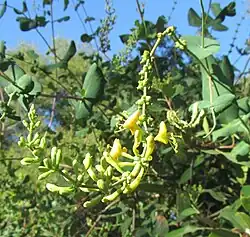Lonicera interrupta
| Chaparral honeysuckle | |
|---|---|

| |
| Scientific classification | |
| Kingdom: | Plantae |
| Clade: | Tracheophytes |
| Clade: | Angiosperms |
| Clade: | Eudicots |
| Clade: | Asterids |
| Order: | Dipsacales |
| Family: | Caprifoliaceae |
| Genus: | Lonicera |
| Species: | L. interrupta
|
| Binomial name | |
| Lonicera interrupta | |
Lonicera interrupta, commonly known as chaparral honeysuckle, is a species of plant found in the western United States.
Description
Lonicera interrupta is a shrub with a woody trunk. The leaves are up to 3.5 centimetres (1+1⁄2 in) long.[1] The plant sends up spiked inflorescences of yellow honeysuckle flowers. Each flower is about 1 centimetre (1⁄2 in) long,[1] with prominent stamens extending from the rolled-back lips.
The fruits are red,[1] spherical, and shiny.
Distribution and habitat
It is native to chaparral and mixed forest habitats[1] in the foothills and mountain ranges of California, and to some mountains in Arizona.
It is hardy and quite drought-tolerant.
Ecology
The flowers are attractive to hummingbirds.
Uses
The fruits are bitter but edible, unlike many members of the genus.[1]
References
- ^ a b c d e Turner, Mark; Kuhlmann, Ellen (2014). Trees & Shrubs of the Pacific Northwest (1st ed.). Portland, OR: Timber Press. p. 307. ISBN 978-1-60469-263-1.
External links